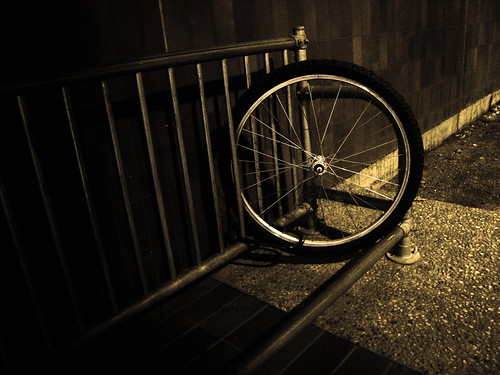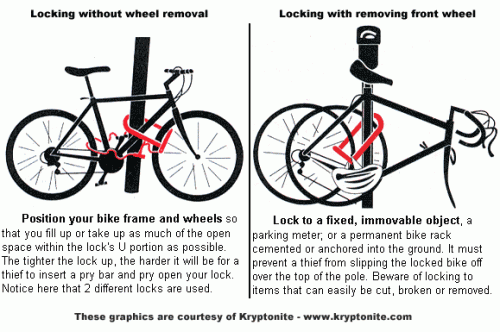
‘Next time, lock up the entire bike’
courtesy of ‘billaday’
I love bike riding. And I love bike riding around DC. It’s truly a fantastic mode of transportation, whether you’re headed to work or play. Since moving to DC in 2006, with my Cannondale in tow, I’ve noticed a significant increase in the amount of bike traffic. I’d most likely attribute this rise to 1) increased Metro fares, 2) the addition of numerous bike lanes and bike racks, in part spearheaded by the WABA, and 3) the increase in popularity of road biking. Sadly, the increase of bike riding has also meant a parallel increase in DC bike theft, and if you’ve ever had your bike stolen, like me, you know how much of a personal affront it is and how irreplaceable your perfectly fitted and outfitted bike was. So, in an effort to prevent further bike theft and the ensuing anguish, I asked Mike Christian of Revolution Cycles for some tips and advice on how to better secure our bikes.
Mike’s first nugget of wisdom is for all riders to buy a U-Lock and cable combo. Whether you park your bike on the street, in a parking lot or in your building’s bike room, these locks will arm you with the best method possible of securing your bike. Mike recommends combo locks from OnGuard Locks, and points out that OnGuard also provides buyers with varying insurance policies when you register, “the insurance that is offered…you pay either 1$ for 1 year, $10 for 2 years, or $15 for 3 years.) Additionally, if you have renters insurance, be sure your bike is added or included in your policy.
When it comes to other types of locks on the market, Mike says heavy chain locks (like the BEAST series) offer a good, but second best level of security, and that cable locks should be avoided because it can be easily and quickly cut through.
From Mike’s experience at Revolution Cycles, the most frequent bike part stolen (from most to least) are the front wheel, back wheel, saddle/seat and then the entire bike. By locking your bike properly with the U-Lock/cable combo, you should avoid wheel thefts, but for the seat Mike recommends buying a saddle lock. Alternatively, bike seats are often removable, so take your seat with you, if you’re not securing it.
Once you’ve got your U-Lock and cable combo, the next step is learning how to use it to secure your bike properly. “You want to aim to get the U-Lock to go through the seat tube and around the rim of the back wheel. From there you want to loop the cable through the front wheel and into the U-Lock, [so] that way both wheels are locked.” Next choose your anchor location; bicycle rails/racks, lamp posts, street signs, or metal railings are good options. Be sure that whatever you secure your bike to, it cannot be unscrewed or easily taken apart. Also try for a location that is frequented by people and is well lit. And don’t lock your bike in the same area all the time; vary your routine up to prevent thieves from scouting your bike’s location and returning to it with their thievery gear.
Ideally, when thieves spy a properly secured bike, they should immediately be deterred from stealing it and should move on. However, if a thief truly sets his/her heart on a bike, as much as it sucks, it’s likely they’ll get it. Should that happen, be sure to report the theft to the MPD.


One more tip for U-Lock users:
When locking up, put the crossbar of the lock up against the frame of your bike (as opposed to up against the thing you’re locking to)
If a thief is going to pry the U-Lock open with brute force they need to get leverage. Using the frame for leverage will likely do irreperable damage to the frame – not something the thief wants.
Obviously this is only a small deterrent in the case where the thief would be prying the entire crossbar off – as opposed to picking the lock or something else. Easy for the cyclist to do, though, so worth remembering.
Locking up just the front wheel is not bright. Also, don’t leave your bike locked up outside overnight. It’s best to take it inside.
You know what I want to know? Why would anyone steal just a piece of a bike? My bike seat was stolen once…what the hell do people do with it?? Is there some underground market for bike parts? Is it just idiot kids with nothing better to do?
@Tracy Unfortunately, there is indeed a market for bike parts (seats, wheels, etc.) Thieves can sell the parts to disreputable bike shops, people on craigslist, restaurants/stores with bike deliverers, etc.
A new wheel will likely cost you somewhere around 100-200 bucks, so I’m guessing a used (aka stolen) wheel would bank a thief 20-50 bucks.
I don’t think the solution from Revolution cycles is wrong. However, I don’t think it’s the most efficient and safe solution to protecting your
bike.
What’s wrong with the Revolution cycles solution? A large U-Lock AND cable is very heavy and bulky to carry around. In addition, a cable of any
kind is easily cut. Go walk around the side streets in Georgetown and look for all the cut cables laying around on the street and you’ll
understand what I’m talking about.
What’s the better solution?
Purchase a set of locking wheel and seat skewers, and then a much smaller U-Lock. The idea here is to remove the quick-release skewers that come
with most bikes, and replace them with ones that require a key. Same with the seat-post quick release. Then you’d buy a smaller, lighter weight
U-lock that only has to lock your frame to an immovable object. This means you never have to fiddle with carrying a cable and large U-lock
because your wheels and seat are ALWAYS locked to your bike, and the small U-lock can fit in your back pocket. Simple. This is what you see a lot
of bike messengers doing. It makes sense, and is a lot more convenient. Yes, the solution links below are not cheap, but neither is replacing
your bike when it gets stolen. Just remember to carry a spare skewer key with you in case you need to change a flat !
Some links:
Since I don’t think links work in the WLDC comments, search Amazon for “Kryptonite Evolution Mini Bike U-Lock – 997931” which is a smaller (yet strong) U-Lock that can fit in the back of your pocket.
As for locking skewers, I’d recommend the PitLock brand, as they are made out of stainless steel, so they won’t rust:
You can find them at www (dot) urbanbiketech (dot) com